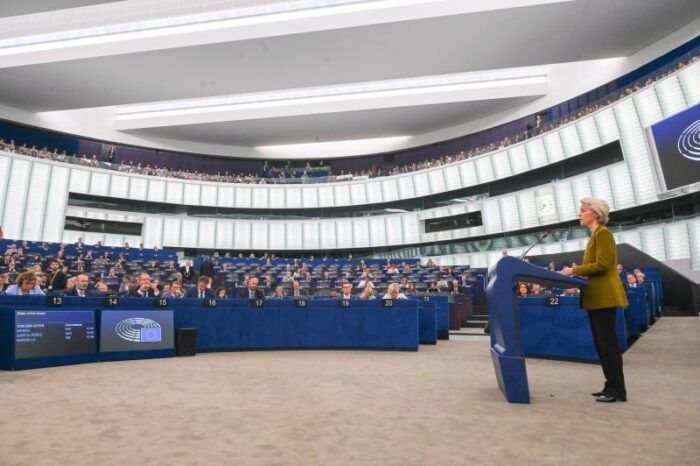The Progressive Post
You want it darker? The Swedish working-class votes, but Social Democrats lose

In the Swedish election, urban voters trusted Social Democratic PM Magdalena Andersson to keep their lives sunny in uncertain times. But small-town Sweden continued to show their disillusion by voting for the Sweden Democrats. The latter trend proved to be stronger as Sweden’s Social Democrats are heading into opposition – in spite of receiving 30.3 per cent (+2.1) of the votes.
In 2018, the Swedish Social Democratic Party made a brilliant ad. Then Prime Minister Stefan Löfven walks up to a quaint hot dog stand and is asked: “What do you want?” Löfven looks into the camera with a warm smile: “I want a society where safety comes before tax cuts.” He continues with the priorities of the election campaign (that was eventually won) and concludes: “And I want a hot dog as well”.
In 2022, a YouTuber made a parody of the ad. When asked “what do you want”, the YouTuber goes on a rant for almost three minutes. He wants returned IS warriors to walk around freely; sky-high electricity prices and an extra tax on petrol; the lowest number of police in the EU and soaring gang criminality; children, teenagers and policemen shot dead in the streets; the highest taxes on earth and low wages for burnt-out teachers and nurses; long queues to access hospital care, beggars everywhere but no midwives – and a hot dog, of course.
This was the darkest election campaign in living memory. The conservative Moderate Party proposed compulsory tests for Attention-Deficit/Hyperactivity Disorder (ADHD) for all five-year-olds in immigrant-heavy suburbs (to counter crime later in life). The Liberal Party suggested mandatory language tests for two-year-olds “who are not enrolled in preschool” (code for children of immigrants). The Social Democrats talked about a cap on residents with “non-Nordic background” in immigrant neighbourhoods, and Magdalena Andersson promised a Sweden without any “Somali-towns”.
This agenda suited the party of the extreme-right – the Sweden Democrats – who calmy put up election posters with airplanes (metaphor: repatriation). Such a poster makes sense if you ever cared to read their party platform, which states that democracy is difficult to keep in a state inhabited by “several peoples” – language that brings the 1930s to mind.
And still, the Social Democrats increased their share of the vote by 2 per cent to 30.3 per cent, and almost won for the third time in a row. The main reasons for the ‘close but no cigar’ situation are the following:
- Magdalena Andersson was a trusted and highly popular Prime Minister.
- The backdrop (albeit absent in the actual campaign) was the national unity during the pandemic – eventually replaced by war in our neighbourhood.
- The Moderates had a quirky candidate for prime minister (Ulf Kristersson) and ran a bad campaign that lacked a larger ‘time for change’ narrative. They focused on an agenda owned by the Sweden Democrats (immigration and crime) to which they mainly added nuclear power and tax cuts. It was surprisingly narrow and lame after being out of office for eight years, and they lost their position as Sweden’s second biggest party (the Moderates got 19.1 per cent, compared to 20.5 perc ent for the Sweden Democrats – shrewdly led by Jimmie Åkesson).
- Ulf Kristersson promised a prominent Holocaust survivor to never, never, never cooperate with the Sweden Democrats. He broke that promise, and the Moderates have still not figured out how they will handle the xenophobic gang that they now rely upon in order to form a government. This danger was obvious to many urban, liberal voters who would subscribe to a quote from John F. Kennedy’s inaugural address: “Those who foolishly sought power by riding the back of the tiger ended up inside”. As a result, many centrist voters in big cities voted for the sitting PM and Social Democratic Party leader ‘Magda’.
- The Swedish labour movement is not what it used to be, but it is still a movement. The Social Democratic Party broke previous records and completed 761,000 verified conversations with voters (canvassing and phone). The unions within the Swedish Trade Union Confederation (LO) talked to over 620,000 of their members.
However, the election was lost. To understand why, let us revisit the steps any Social Democrat campaign should include:
- Neutralise what stands between yourself and the voters. In order to do so, the Social Democratic Party has adopted a tougher stance on migration beginning already in the autumn of 2015. Now, Magdalena Andersson promised to “leave no stone unturned” in the fight against criminal gangs.
- Present breathtaking reforms that will improve welfare and schools for working families. Add green transition and new jobs to underline that you embrace the future with hope.
- Hit your opponent hard. If their candidate for PM comes with problematic political luggage, make sure to have surrogates that can unpack and show voters the dirty laundry.
The Social Democratic campaign completed the first step, but never managed to move the election to their own turf. This was an opportunity lost. As voters walked out of the polling booths, they said that health care was their most important issue, with schools as well as law and order in second place. The election ought to have moved beyond immigration and crime, big reforms were lacking, and key ministers could have done better. But if we put our Marxist glasses on, larger trends among the factors of production are at play.
Concerning inequality, no other country has seen a faster increase since the 1990s. Concerning immigration, 20 per cent of our population was not born in Sweden. Concerning schools, health clinics and elderly care, voucher systems and profit-making companies are holding the baton.
If you apply these trends to urban areas and the countryside, you can see a growing divide that was reflected in the election result. Urban voters (successful ‘anywheres’) trusted Magdalena Andersson to keep their lives sunny in these uncertain times. Small-town Sweden (displeased ‘somewheres’) has had a disproportionate share of the flip side of the trends above and sends their signal by voting for the Sweden Democrats.
The urban-rural political divide should be analysed in tandem with the gender gap. If only women voted, the Social Democrats would have received 34 per cent of the vote. If you include their allies (Greens, Left Party, Centre Party) the victory would have been rock solid: 56 per cent. But with only men at the ballot box, the Social Democrats and the Sweden Democrats are tied (26 and 25 per cent respectively). And if we only count the male vote, the right-wing bloc (Sweden Democrats, Moderates, Christian Democrats, Liberals) collects 56 per cent instead.
As a result, polarisation (for or against the Sweden Democrats) and cannibalism (among the red-green parties) walked hand in hand. The Social Democrats (notably ‘Magda’) gained votes from their allies (Greens, Left Party, Centre Party) – but the bleeding to the Sweden Democrats continued in this election as well. Winning votes from your friends, and not moving voters across the aisle by completing step two and three of an election strategy, proved fatal.
Like in the rest of Europe, the overriding challenge for Social Democrats is to find bold reforms that can reverse the strong trends that divide our country and allow populists to grow. Ideally, this should be done while building sustainable societies at the same time. Lack of progress in this regard during the last eight years of governing with a very divided parliament should be added to the list of explanations. The divide kept growing, and voters on the wrong side took notice. The working class decided the outcome, and the Social Democrats lost: Among ‘workers’, the Social Democratic Party got 31,8 per cent, while the Sweden Democrats got 28,8 per cent. Among trade unions members within LO, the numbers were better but not good: 42,4 per cent voted for the party led by ‘Magda’, and 27,2 per cent for Jimmie Åkesson’s party.
In any election, there are additional trends to account for. The affection for nuclear power within the right-wing block paid off as the energy crises emerged. A new party (‘Nyans’) gained ground in immigrant suburbs and won crucial votes of the Social Democrats (therefore it can be said that a party with Islamist ties helped the former Nazis). A growing amount of voters with immigrant background are voting for the far-right, like in other European countries. Young voters vote heavily for the Moderates and the Sweden Democrats, while the left seems absent in the digital world where young minds are formed. Electoral participation headed south – from 87.2 per cent in 2018 to 84.2 per cent this time – probably hurting the centre-left parties the most.
Sweden has ended up with a right-wing party that is bigger and much more extreme than in other European countries. One example: the candidate they have for Speaker of the Riksdag – Björn Söder – has said that you cannot be a Swede and a Jew, or a Swede and a Sami. And we tried to expose their Nazi roots, but they continued to grow. The right-wing parties in Sweden offered them a warm embrace – but were surpassed by them.
The Sweden Democrats have grown bigger in nine elections in a row and only one strategy seems to remain: turn all your attention to the trends dividing Sweden – not least segregation and inequality. Stand tall and dare to propose your own solutions, grounded in the idea of the primacy of politics, and built on the fact that there is more that unites us than divides us. When your traditional opponents go low with the extreme right, you go high putting the whole country and ordinary folks first. Because one of the parties to the left of the centre needs to win back the confidence of working people across the land, and only the Social Democrats can do that. And while doing this, look out for your neighbour as racism and xenophobia always grow when parties who speak to our darker angels gain ground.
So, no more time for hot dogs. Time to get to work.
Photo credits: Shutterstock.com/Aleksandros Michailidis




